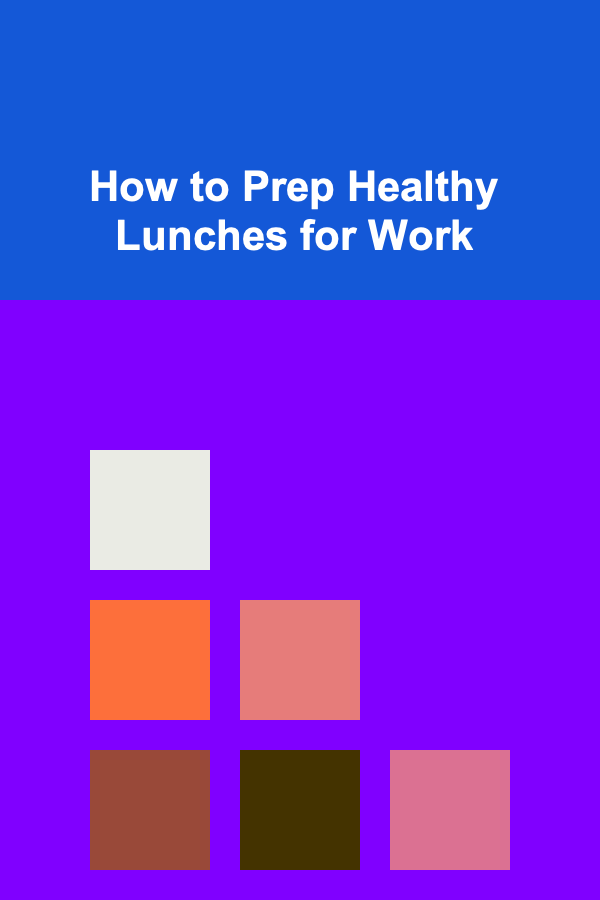
How to Prep Healthy Lunches for Work
ebook include PDF & Audio bundle (Micro Guide)
$12.99$7.99
Limited Time Offer! Order within the next:

Eating healthy at work is essential for maintaining both physical and mental well-being, especially in a busy, demanding work environment. However, with hectic schedules, it can be easy to fall into the trap of grabbing fast food or packaged meals that are not always the healthiest options. Preparing healthy lunches ahead of time is an effective way to stay on track with your nutrition goals, save money, and reduce stress during your workday.
This article offers detailed strategies for preparing healthy lunches for work, including meal prep tips, ingredient ideas, and simple recipes that are not only nutritious but also quick and easy to prepare. Whether you're working from home or in the office, these strategies can help you build a balanced, healthy lunch that fuels you throughout the day.
Why Meal Prep Is Important for Healthy Work Lunches
Meal prepping involves preparing and cooking meals ahead of time, typically for the week. This practice offers numerous benefits, especially for those with busy work schedules. Below are the key reasons why meal prepping is an essential part of healthy lunch preparation:
1.1 Time-Saving
Meal prepping saves you time during the workweek by allowing you to simply grab a prepared meal or assemble ingredients that are already cooked. It eliminates the need to spend time each day thinking about lunch or waiting in line for takeout.
1.2 Cost-Effective
By preparing your own lunches at home, you can avoid the temptation to spend money on takeout or dining out. Meal prepping is far more affordable, especially when you buy ingredients in bulk and plan meals around cost-effective staples like rice, beans, and seasonal vegetables.
1.3 Portion Control
When you prepare your own meals, you can control portion sizes, which is especially important for maintaining a healthy diet. This helps you avoid overeating and makes it easier to stick to your nutritional goals.
1.4 Better Nutrition
By preparing meals from scratch, you have full control over the ingredients, allowing you to create nutrient-dense, balanced meals. You can avoid the excess salt, sugar, and unhealthy fats that often come with pre-packaged or takeout food.
Key Elements of a Healthy Work Lunch
A healthy lunch should be balanced, providing a combination of macronutrients (carbohydrates, protein, and fats), as well as vitamins and minerals. When prepping lunches for work, aim for meals that:
- Include lean protein: Protein helps keep you full and provides the building blocks for muscle repair and growth. Examples of lean protein include chicken, turkey, tofu, tempeh, eggs, beans, and legumes.
- Contain healthy fats: Healthy fats are important for heart health and brain function. Sources of healthy fats include avocado, nuts, seeds, olive oil, and fatty fish like salmon.
- Are rich in fiber: Fiber is essential for digestion and keeping you feeling satisfied. Include a variety of vegetables, whole grains, and legumes in your meals to increase fiber intake.
- Incorporate a variety of vegetables: Vegetables are packed with vitamins, minerals, and antioxidants. Aim to include a rainbow of colorful veggies in your meals, such as leafy greens, bell peppers, carrots, and cruciferous vegetables like broccoli and cauliflower.
- Avoid processed foods: Processed foods often contain added sugars, preservatives, and unhealthy fats. Focus on whole foods whenever possible.
Steps for Preparing Healthy Lunches for Work
The process of preparing healthy lunches can be broken down into a few simple steps. Below is a step-by-step guide to help you get started with meal prepping:
3.1 Step 1: Plan Your Meals
The first step in meal prepping is planning your lunches for the week. Take some time to think about what you want to eat and how you can create balanced meals. It's helpful to have a general idea of the types of meals you want to prepare, and plan around ingredients you already have on hand or items that are on sale at your local grocery store.
- Choose simple recipes: For meal prep to be successful, choose recipes that are easy to make in large batches and store well. Dishes like salads, grain bowls, stir-fries, and soups are great options for meal prep.
- Mix up your meals: Aim for variety to avoid getting bored with the same meals every day. Incorporate different protein sources (e.g., chicken, tofu, chickpeas), grains (e.g., quinoa, brown rice, farro), and vegetables.
- Consider dietary preferences: If you follow a particular diet (e.g., vegetarian, gluten-free, low-carb), plan your meals accordingly.
3.2 Step 2: Create a Shopping List
Once you've planned your meals, create a shopping list based on the ingredients you'll need. Make sure to check your pantry and fridge to see what you already have to avoid buying duplicate items.
- Buy in bulk: To save money, buy staples like grains, beans, lentils, and nuts in bulk. This is often cheaper than buying smaller packages.
- Shop for fresh produce: Fresh vegetables and fruits can be incorporated into your meals, but also consider frozen options. Frozen vegetables and fruits are often just as nutritious as fresh, and they last longer, reducing waste.
3.3 Step 3: Prep Ingredients
Once you have your ingredients, the next step is prepping them. This may involve washing, chopping, or cooking certain ingredients ahead of time so that you can easily assemble your lunches throughout the week.
- Cook grains and proteins: Cook a large batch of your chosen grains (e.g., brown rice, quinoa) and proteins (e.g., chicken, beans) at the beginning of the week. Store them in separate containers for easy assembly later on.
- Wash and chop vegetables: Pre-chop vegetables that you'll use for salads, stir-fries, or bowls. Store them in airtight containers to keep them fresh.
- Make dressings and sauces: If you plan to use salad dressings or sauces in your meals, make them ahead of time and store them in small containers. This will save you time and prevent you from reaching for store-bought dressings, which can be high in sugar and preservatives.
3.4 Step 4: Assemble Your Meals
Now that all the components are prepared, it's time to assemble your meals. For easy-to-grab lunches, invest in high-quality meal prep containers that are microwave-safe, leak-proof, and portion-controlled.
- Layer your ingredients: If you're making salads or bowls, start with a base (e.g., greens or grains), then add your protein and vegetables. Keep dressings and sauces separate to prevent your meals from getting soggy.
- Store meals properly: Make sure your meals are stored in airtight containers in the fridge to keep them fresh throughout the week. Most meal-prepped lunches last for up to 4-5 days, but you can freeze some meals (like soups or casseroles) to enjoy later.
Healthy Lunch Ideas for Work
Here are some healthy lunch ideas that are perfect for work:
4.1 Grain Bowls
Grain bowls are a great meal prep option because they are versatile and easy to make in large batches. Here are a few combinations to try:
- Quinoa and Chickpea Bowl: Quinoa, roasted chickpeas, avocado, cucumber, cherry tomatoes, and a lemon-tahini dressing.
- Brown Rice and Tofu Bowl: Brown rice, sautéed tofu, steamed broccoli, carrots, and a sesame-ginger dressing.
- Farro and Roasted Vegetables: Farro, roasted sweet potatoes, cauliflower, kale, and a balsamic vinaigrette.
4.2 Salads
Salads are easy to prepare in advance, and you can mix and match ingredients to suit your taste:
- Mediterranean Salad: Mixed greens, cherry tomatoes, cucumber, Kalamata olives, feta cheese, and a red wine vinaigrette.
- Chicken Caesar Salad: Romaine lettuce, grilled chicken, homemade whole wheat croutons, and a light Caesar dressing.
- Mason Jar Salad: Layer ingredients in a mason jar, starting with the dressing at the bottom and adding vegetables, protein, and greens at the top. Shake it up when you're ready to eat.
4.3 Wraps and Sandwiches
Wraps and sandwiches are easy to assemble and transport. Use whole grain wraps or bread for extra fiber and nutrition:
- Turkey and Avocado Wrap: Whole wheat wrap, turkey, avocado, spinach, and mustard or hummus.
- Vegetarian Wrap: Whole wheat wrap, hummus, cucumber, bell peppers, spinach, and shredded carrots.
- Grilled Chicken Sandwich: Whole grain bread, grilled chicken, lettuce, tomato, and mustard.
4.4 Soups and Stews
Soups and stews are perfect for meal prep, as they tend to taste even better after sitting for a day or two:
- Lentil Soup: Lentils, carrots, celery, onions, and tomatoes, simmered in vegetable broth with spices like cumin and turmeric.
- Chicken and Vegetable Soup: Chicken, carrots, celery, onions, and spinach in a flavorful chicken broth.
- Butternut Squash Stew: Butternut squash, sweet potatoes, kale, and chickpeas in a spiced tomato broth.
Conclusion
Meal prepping for work is a game-changer when it comes to eating healthy on a regular basis. By planning, prepping, and storing your lunches in advance, you can save time, money, and effort while still enjoying delicious and nutritious meals throughout the week. By focusing on balanced meals with lean proteins, whole grains, healthy fats, and plenty of vegetables, you'll be able to fuel your body for productivity and overall well-being. Start small, experiment with different recipes, and gradually build a routine that works best for you. Your future self will thank you.

How to Build Wealth Using a Diversified Investment Strategy
Read More
How to Create a Functional and Organized Craft Corner
Read More
How to Create a Sustainable Savings Plan for Your Goals
Read More
How to Design a Multi-Use Room That Saves Space
Read More
How to Dust Your Home More Effectively
Read More
Cultivating Rationality in Decision-Making
Read MoreOther Products

How to Build Wealth Using a Diversified Investment Strategy
Read More
How to Create a Functional and Organized Craft Corner
Read More
How to Create a Sustainable Savings Plan for Your Goals
Read More
How to Design a Multi-Use Room That Saves Space
Read More
How to Dust Your Home More Effectively
Read More